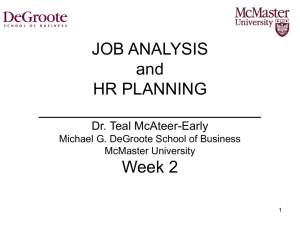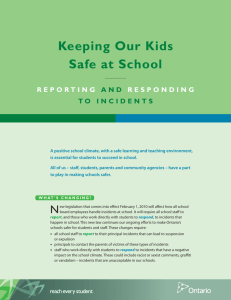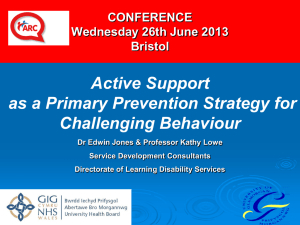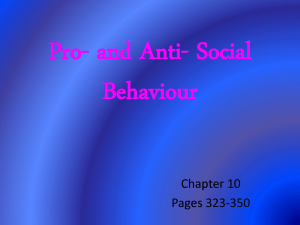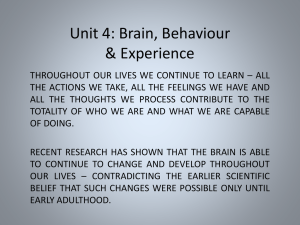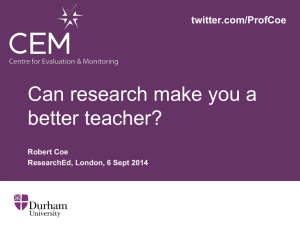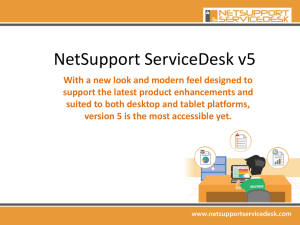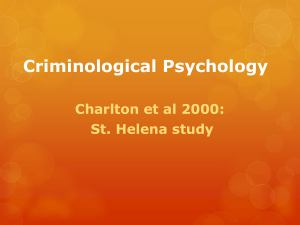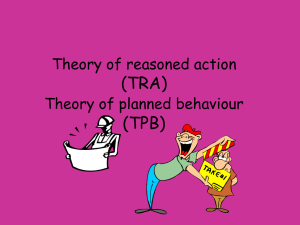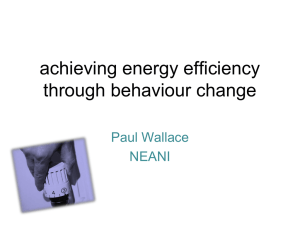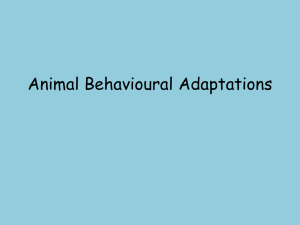Job - DeGroote School of Business
advertisement
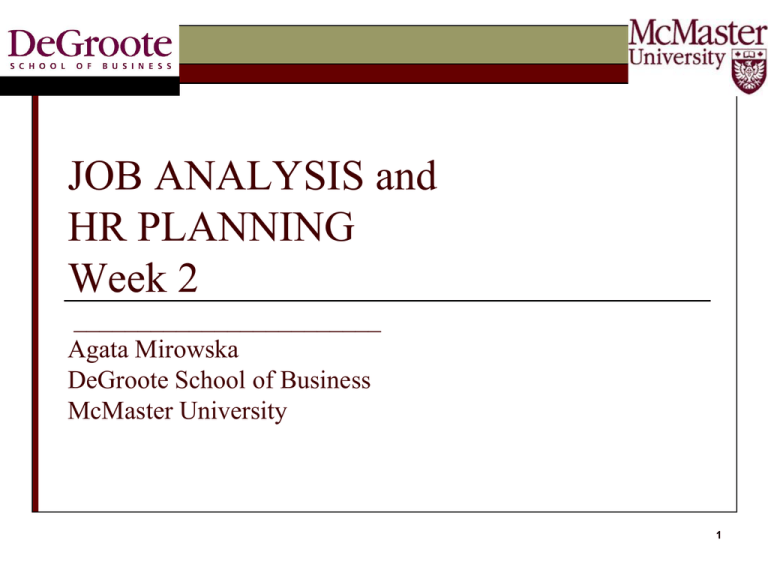
JOB ANALYSIS and HR PLANNING Week 2 ________________________ Agata Mirowska DeGroote School of Business McMaster University 1 Human Resource Strategies Planning HR Attracting HR Placing, Developing & Evaluating HR Motivating and Rewarding HR Maintaning high performance What is a job? Job Tasks Group of related activities and duties Made up of tasks Basic elements of jobs “what gets done” Position Tasks and responsibilities performed by one individual 3 What is Job Analysis? Job analysis (JA) systematically collects, evaluates, and organizes information about jobs JA identifies behaviours, knowledge, skills, and abilities (KSAs) that are critical to a job 4 In-Class Discussion Why is JA Important What HR systems use JA Information 5 What is the purpose of JA? JA lays the foundation for HRM systems: Selection Selection system developed to assess key KSAs Ensures that it is job-related Training Gaps in KSAs of new hires represent training needs 6 What is the purpose of JA? Performance Appraisal Job analysis establishes performance standards Compensation Relative worth of jobs measured via job evaluation 7 What is the purpose of JA? JA helps you to select the right employee, evaluate the employee fairly, compensate, and train the appropriate skills to the appropriate employees (in theory) JA also ensures your system is legally defensible and perceived as fair (procedural justice) Job Analysis Process Prepare for JA Collection of JA information Use of JA information Steps in Job Analysis Process Phase 1: Preparation for job analysis 1. 2. 3. Familiarization with the organization and its jobs Determine the uses of the JA information (selection, training?) Identify what jobs need to be analyzed • • • Critical to success of the organization Difficult to learn New technology 10 Steps in Job Analysis Process Phase 2: Collection of Information 1. Determine sources of job data Human and nonhuman 2. Data collection instrument design Job analysis schedules 3. Choice of method for data collection Interviews Mailed questionnaires Employee log Observation Combinations 11 Existing JA Methods(Instruments) Functional Job Analysis (FJA) Position Analysis Questionnaire (PAQ) Critical Incident Technique (CIT) 12 Functional Job Analysis (FJA) Fine & Wiley (1971) Focuses on task statements Task statements include: What? - What gets done (the action/behaviour) To whom or what? - The object of the action Why? - Purpose of the action How? - What facilitates the action? 13 Functional Job Analysis Tasks are rated on scales reflecting varying degrees of involvement with Things, Data, and People as well as math, language, etc. requirements Each scale is arranged hierarchically E.g., People scale ranges from “taking instructions” to “leadership” 14 Position Analysis Questionnaire (PAQ) McCormick (1972) Developed because of criticism that JA relied on observation – not quantifiable Detailed questionnaire (194 tasks) Determines extent to which each task is applicable to target job Using a 5-point scale 15 Critical Incident Technique Flanagan (1949) Identifies behaviours that indicate success or failure on the job Effective vs ineffective behaviours Critical Incidents include: Context - in which the incident occurred Behaviour - exactly what the individual did that was effective or ineffective Consequences - of the behaviour and whether or not consequences were in the employee’s control 17 Developing Critical Incidents Interview those who are familiar with the job E.g., supervisors, subordinates, customers Ask them to describe specific incidents of effective / ineffective behaviour by incumbents of target job Incident context – What led up to the incident (background)? What was the situation? Behaviour – What exactly did the person do that was effective / ineffective? Consequence - What was the outcome of the behaviour? 18 In-Class Exercise In groups, develop critical incidents for a specific job with which you are familiar. (Non-managerial preferred) Generate at least: 3 incidents of effective behaviour and 3 incidents of ineffective behaviour 19 Critical Incident Technique • • • • Think of someone who has been (in)effective in this specific job. Think of a specific incident that you saw occur that made you think they were (in)effective What were the circumstances surrounding the incident? What was the situation? What exactly did they do that was (in)effective? • • Make sure you are describing observable behaviour What were the consequences of the behaviour? Were the consequences due to the person’s behaviour? 20 Phase 3: Use of Information Job Descriptions Job Specifications Job Analysis Information Job Design Job Performance Standards Phase 3: Use of Information 1. Job descriptions—Task requirements Statement that explains duties working conditions, etc. of a job 2.Job specifications—Person requirements Statement of what a job demands of the incumbent E.g., knowledge, skills, abilities (KSAs) and other characteristics required to perform job 22 Phase 3: Use of Information 3. Performance standards 4. Job Design What is expected of workers JA may provide performance standards for job Identify job duties, characteristics, and competences Consider organizational, employee, environmental and ergonomic factors All of these uses become the foundation for various HRM systems 23 Job Characteristic Model Jobs that provide: Autonomy Variety Task identity Feedback Task significance Lead to meaningfulness, responsibility and knowledge of outcomes, leading to higher motivation, job satisfaction and productivity Job Specialization As work force becomes more educated and affluent, seek accomplishment, recognition and psychological growth Job rotation Job enlargement Job enrichment Employee involvement and work teams Competency-Based Alternative Alternative to traditional job analysis Competencies Many different definitions exist Any knowledge, skills, trait, motive, attitude, value, or other personal characteristic that is essential to perform the job and that contributes to superior performance and organizational success 26 Competency Architecture Core Competencies Apply to all jobs in the organization Support organization’s mission E.g., trust, communication, team orientation, adaptability Functional Competencies Apply to a group of similar jobs E.g., customer service orientation Job-Specific Competencies Apply to all employees in the same job E.g., ability to operate cash register 27 Why / When use Competency Models? Describe job requirements in ways that extend beyond the job itself More future-oriented, more organization-focused Describe and measure an organization’s workforce in more general and comparable terms Increase flexibility in staffing and job assignments 28 Competency: Team Orientation INDIVIDUAL CONTRIBUTOR (behaviours) • Recognizes that own success is linked to team success • Supports team roles, norms, and decisions • Speaks up when he/she feels the team is heading in the wrong direction • Seeks and maintains positive relationships with teams and others outside of own group • Keeps other informed of decisions and information that may impact them 29 Competency: Team Orientation MANAGER (behaviours) Creates and monitors teams appropriate to meet business objectives Sets clear expectations for teams Works to build commitment toward common goals Provides resources for team projects Recognizes team for contributions to goal accomplishment Measures own success by team’s success Break Human Resource Planning HR Planning systematically forecasts an organization’s future demand for and supply of employees and matches supply with demand. Involves -Forecasting demand -Forecasting supply -Addressing labour shortages and surpluses 32 HR Demand and Supply Forecasting Demand Forecasting Supply External Socio-political-legal Economic; Technological Competition External; Labour market analysis Community attitudes Demographic trends Organizational Organizational strategy Budgets; Sales forecasts New ventures; org/job design Internal HR audit/Current employees’ KSAs Succession planning replacement charts Management inventories Workforce Retirements, resignations, terminations, leaves of absence 33 Forecasting Techniques used to Predict HR Demand Expert Forecasts Trend Projection Forecasts E.g. Informal and formal survey E.g. Statistical analysis Other Forecasting Methods Budget and planning analysis New-venture analysis 34 When is there a mismatch between Supply and Demand? Strategies to Match Supply and Demand for HR Strategies for a Loose Labour Market (Oversupply) - hiring freeze - job sharing/job splitting - internal transfers - layoffs, terminations, outplacements - leave without pay - loaning or flexforce 36 Matching Strategies cont… Strategies for a Tight Labour Market (Shortage) - overtime - PT, contingent, contract workers - temporary employment agencies - employee leasing - transfers - hiring FT workers 37 Emerging Work Options & Arrangements Shorter work week Flextime Flexiplace Telecommuting Virtual organizations Just-in-Time Employees 38 Strategic Issues re: HR Planning 1. Must know organization’s short and longterm goals 2. Different organizational strategies require different human resource plans 3. Human resource planning facilitates proactive response to environmental and legal challenges 39 Strategic Issues re: HR Planning 4. 5. An organization’s tactical plans must be aligned with HR plans Alignment between organizational and HR plans provides basis for timely and effective recruitment and selection. 40 Questions / Comments ? 41
